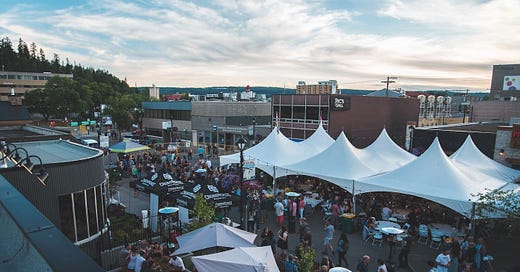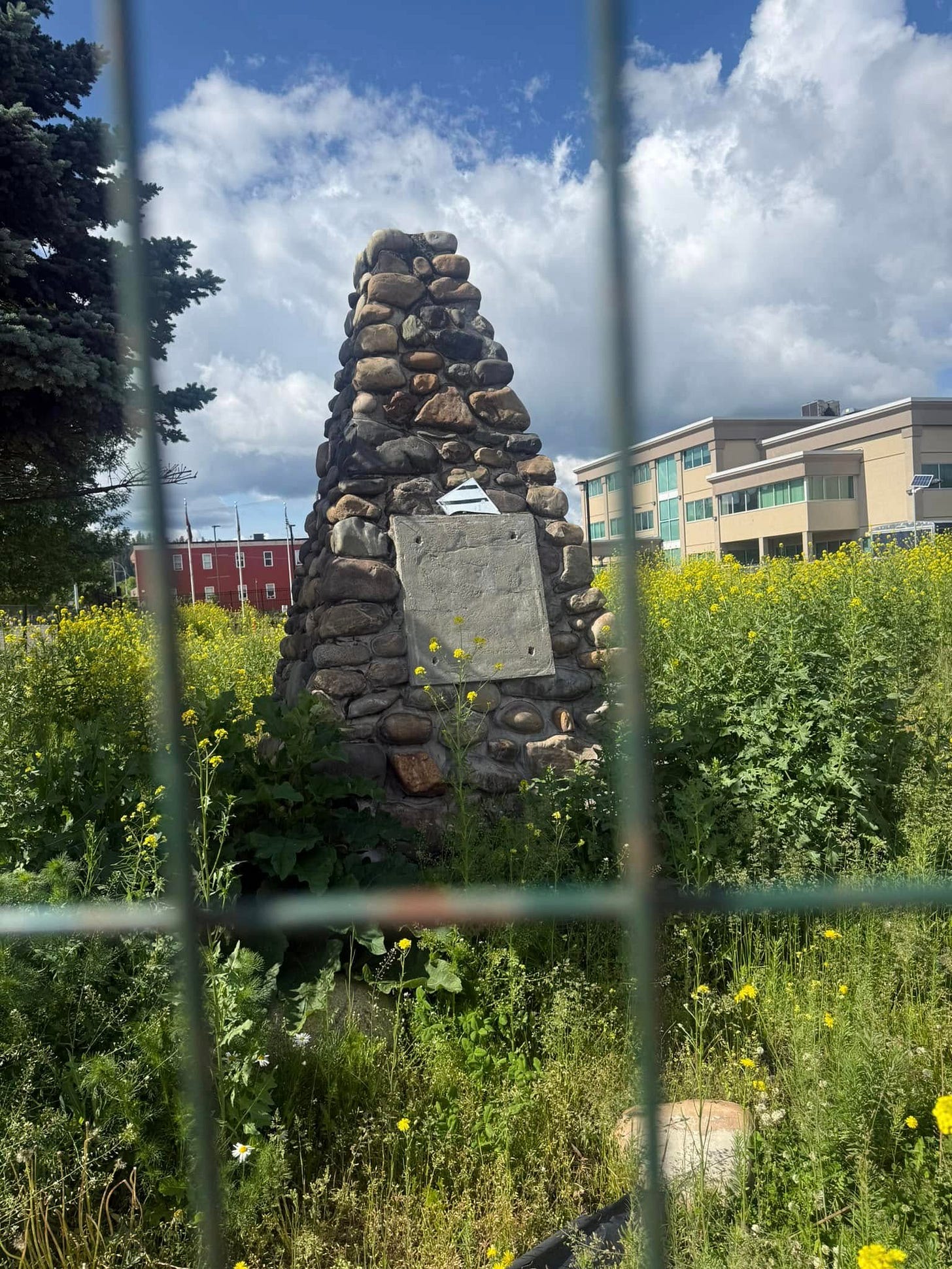Welcome to the NORTHERN HERITAGE Newsletter # 19 and thank you for joining our journey of discovery into the heritage of Prince George and Northern BC.
Today I want to catch up briefly on a number of issues that have been on my mind and quite possibly on some of yours… all related to heritage, community and change in Prince George.
Support for Darrin Rigo’s Vision of Downtown
In his great newsletter North of Somewhere (July 9, 2025) entitled Downtown Parks become downtown parking lots, Darrin said some very important things about the well known problems facing Prince George’s downtown and how the behaviour of PG people reveals their real feelings about it all. He champions:
City-funded street festivals, adding new benches and comfort amenities, revitalizing downtown parks and squares, having the time/staff to quickly process permits, funding collaborative events that draw people downtown, bigger and more abundant trees and gardens, incentive programs for things like patio expansions, marketing grants, building facade improvements, the time/resources to think of strategies that might force slumlords to sell or lower prices, widening sidewalks to increase walkability, building out better transit systems, having protected bike infrastructure, etc etc etc.
And he points out that despite the homeless problem, parking and other issues:
LITERALLY every time the City or Crossroads or Tourism PG or some entity HAS put on some sort of downtown festival, the whole damn city arrives so that is just not true.
Remember the “Light Up The Plaza” festival last winter?
Or every weekend’s Farmer’s Market or the annual Crossroads Street Festivals?
I don’t accept that our downtown is just “bad” or not a destination for events and markets - that no one goes downtown because it’s so unsafe or whatever.
We REGULARLY disprove that theory.
The Farmers’ Market Photo: Darrin Rigo
He’s promoting what he calls a pragmatic approach - actions we can take that are within our control and would cumulatively impact downtown positively - from benches and outdoor seating to planting, public art, music and food stalls to full scale festival events in downtown streets. as Darrin says:
all of these together have a cumulative effect and I think much the way downtown feels like its dying a slow death, it might also be able to slowly be resuscitated, CPR given one breath and chest compression at a time.
I agree with him entirely and although the vision may seem idealistic, that’s exactly how things get done. Have a look at the Project for Public Spaces, Happy Cities, The City at Eye Level in Hong Kong or Think City’s work in Kuala Lumpur.
If they can do it then why can’t we?
The Alexander Mackenzie Cairn
Prince George’s Train Lady, Linda Campbell, wrote a series of heartfelt pieces on Facebook about the Regional District decision to buy Millennium Park at 101 George Street from the City for $1 and turn it into a parking lot. There is a history marker on the lot, a cairn made of local river boulders that was set up in 1923 with a plaque commemorating the arrival of Alexander Mackenzie and his team of indigenous and French Canadian fellow travelers to the site of what eventually became Prince George as they searched for a water route from Lake Athabasca to the Pacific Ocean in the 1790s. The plaque was removed and is now on a newer monument located in Lheidli T’enneh Park. Later a plaque was placed on the cairn to acknowledge the arrival of the railway to Prince George but it too was removed and for decades the cairn has been more or less abandoned.
Even so, it has been on the City of Prince George Heritage Inventory since 2010.
The Mackenzie Cairn, Millennium Park Photo: Linda Campbell
With the handover of the park, the regional district is apparently working with the Lheidli T’enneh First Nation to arrange dismantling of the cairn and honorable return of the stones to the Fraser from which they came.
In strict heritage terms the cairn without its plaque may be deemed to have little or no heritage value as the cairn’s commemorative function is now performed by the monument in Lheidli T’enneh Park. However, it is clear from Linda’s accounts that the cairn and its location continue to have valuable meaning for many long term Prince George residents, particularly those like Linda who grew up downtown in its 1st Avenue neighbourhood.
The question which all of this raises is “how does an item of Inventoried Heritage get written off without any community discussion, only to be presented to the public as a done deal?” Linda and the vocal community that has responded to her Facebook journalism never had the chance to express their ideas on the subject.
Does this sound like a system that is going to protect our heritage when it REALLY matters to all of us? I think we need to seriously investigate and discuss this….
What if the next heritage to be ‘un-inventoried’ and ‘disappeared without consultation’ is the Little Prince Steam Engine, the Knox United Church Bell or the Chinese Canadian Memorial - all on the Inventory and on Exploration Place’s 100+ Prince George Icons?
Recommendations from NORTHERN HERITAGE
In addition to our local heroes North of Somewhere and Northern Capital News, I want to recommend a Substack newsletter I have recently discovered called Canadian Returnee - “Explore the stories of returning to Canada after years abroad, with reflections on identity, belonging, and a fresh view of home and the world.” With titles like - What Canada Gets Right and What We Risk Losing, Why Every Child in Canada Knows Terry Fox, What People Get Wrong About Canada and Lessons for Canada from Hong Kong and Los Angeles, I find it fascinating, no doubt attracted by the idea that it’s written by another Canadian returnee!
Have a look at Creating Communities by my sometimes co-author Eric Sandelands who shames me by his sheer volume of writing and variety of topics!
I am also looking forward to reading a soon-to-start newsletter called Decent Tuesdays on the Main Street Journal Substack - on ‘localization’ and the role and responsibility for action at the local community level; a commitment to place to address the increasingly complex and pressing issues of cities in the 21st century.
Wise Words on Heritage
“…. the sense of place cannot be observed, nor instantly created for that matter, by present day urban planning practices as part of the fashion of ‘place-making’ in new developments. It is typically the the aggregate of individual perceptions, which is expressed collectively, from the community that lives, works and socializes in a place, rather than the limited knowledge and perceptions acquired by transient visitors.
Fundamentally, it is local communities who make places - not architects or designers.” (The Historic Urban Landscape: Managing Heritage in an Urban Century by Bandarin and Van Oers, p. 107)
If you found this and my previous newsletters interesting or valuable, I hope you’ll consider buying me a coffee! For now I hope to keep this newsletter free with no paywall so that I can reach as many readers as possible, but even a few dollars now and then can make a big difference - Scan the code and support my writing - and the coffee that keeps me at it!
Respectfully acknowledging that I work, learn, and live on the ancestral lands of the Lheidli T'ehnneh peoples.








Ayesha, you write so well and thank you for highlighting our lovely cairn and park. Talk soon😌
Thanks for the article! As a resident of Powell River, it's interesting to see how PG is (and isn't) responding to similar issues - particularly the decay of historic town centers in favour of car-centric infrastructure.